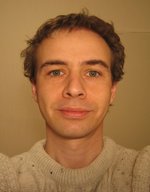Invited Talk February 2007
Dr. Vincent Lepetit

|
Dr. Vincent Lepetit (Computer Vision Laboratory, Ecole Polytechnique Federale de Lausanne (EPFL)) will be giving an invited talk on Thursday, Feb. 1, 10:30-12:00, in room MI 00.13.009A and on Friday, Feb. 2, 09:30-10:30 in room MI 03.13.010, Garching. on "Real-Time 3D Tracking in Monocular Sequences" and "Keypoint recognition in ten lines of code" |
Abstract:
Real-Time 3D Tracking in Monocular Sequences
3D Tracking in monocular sequences aims to recover the full 3D position and orientation of an object or the camera from a video sequence only. It has many potential applications, including Augmented Reality and Visual Servoing in robotics. I will present an overview of the mathematical foundations and the techniques developed these last years. In particular, I will address the following topics: Model-Based 3D Tracking; Pose estimation from point correspondences or planar structure; Bayesian tracking; Robust estimation; Fiducial-based and Natural feature-based tracking; Object detection for tracking applications.Keypoint recognition in ten lines of code
While feature point recognition is a key component of modern approaches to object detection, existing approaches require computationally expensive patch preprocessing to handle perspective distortion. We show that formulating the problem in a Naive Bayesian classification framework makes such preprocessing unnecessary and produces an algorithm that is simple, efficient, and robust. Furthermore, it scales well to handle large number of classes. To recognize the patches surrounding keypoints, our classifier uses hundreds of simple binary features and models class posterior probabilities. We make the problem computationally tractable by assuming independence between arbitrary sets of features. Even though this is not strictly true, we demonstrate that our classifier nevertheless performs remarkably well on image datasets containing very significant perspective changes. We applied our classifier to real-time 3-D object detection and pose estimation. It is trained online by slowly moving the target object with respect to the camera. This is made possible by the great flexibility of our classifier, which lets us add and remove feature points to our list as needed with a minimum amount of extra computation. Biography:Vincent Lepetit received the engineering and master degrees in Computer Science from the ESIAL in 1996. He received the PhD degree in Computer Vision in 2001 from the University of Nancy, France, after working in the ISA INRIA team. He then joined the Virtual Reality Lab at EPFL (Swiss Federal Institute of Technology) as a post-doctoral fellow and became a founding member of the Computer Vision Laboratory. He has received several awards in Computer Vision including the best paper award at CVPR 2005. His research interests include vision-based Augmented Reality, 3D camera tracking, and object recognition.
| WebEventForm | |
|---|---|
| Title: | Talks by Dr. Vincent Lepetit |
| Date: | 1 February 2007 |
| Location: | 00.13.009A; 03.13.010 |
| Abstract: | Dr. Vincent Lepetit from the Computer Vision Laboratory of the Ecole Polytechnique Federale de Lausanne (EPFL) is giving two talks on Real-Time 3D Tracking in Monocular Sequences and Keypoint recognition in ten lines of code |
| Imageurl: |  |
| Type: | News |
